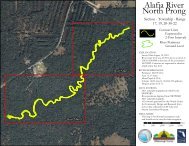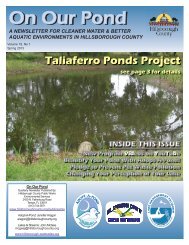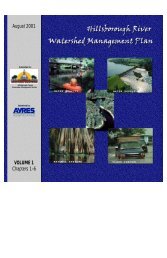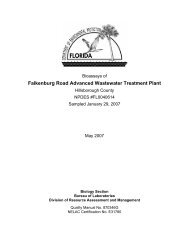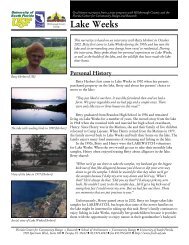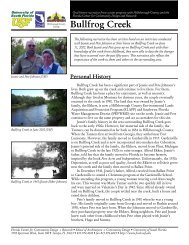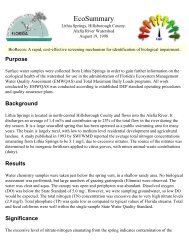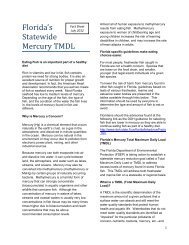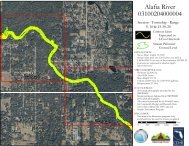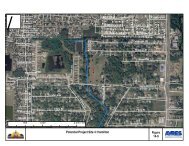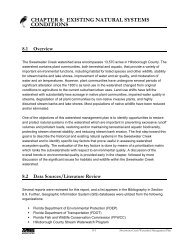Rocky Brushy Creek Watershed Mgmt. Plan (2007) -- Part 2
Rocky Brushy Creek Watershed Mgmt. Plan (2007) -- Part 2
Rocky Brushy Creek Watershed Mgmt. Plan (2007) -- Part 2
You also want an ePaper? Increase the reach of your titles
YUMPU automatically turns print PDFs into web optimized ePapers that Google loves.
CHAPTER 8problems; and8. informing and educating resource managers about which species deserve to be monitored,and to help managers set priorities for management.The Council’s Florida chapter, the Florida Exotic Pest <strong>Plan</strong>t Council (FEPPC), compiles a list ofFlorida's most invasive exotic plant species every few years, grouping them according to degree ofinvasiveness. The most recent compilation can be found at the end of this chapter. The FEPPChas also developed a database map for the Noxious and Exotic Weed Task Team of Category Ispecies throughout the state. A review of this database resulted in the list of FEPPC Category Ispecies occurrence within Hillsborough County, which are described individually below.This list is based on the definitions of invasive exotic species made by the EPPC Committee:• Category I are exotic pest plants that invade and disrupt Florida’s native plant communities;• Category II are exotic pest plants that have the potential to invade and disrupt native plantcommunities as indicated by (1) aggressive weediness; (2) a tendency to disrupt naturalsuccessional processes; (3) a similar geographic origin and ecology as Category I species;(4) a tendency to form large vegetative colonies; and/or (5) sporadic, but persistent,occurrence in natural communities;• (N) indicates a species listed as noxious on the United States Department of Agricultureand the Florida Department of Agriculture and Consumer Services lists; and• (P) indicates a species listed as prohibited by the Florida Department of EnvironmentalProtection under Rule 62C-52, F.A.C.Exotic <strong>Plan</strong>ts in the <strong>Rocky</strong>/<strong>Brushy</strong> <strong>Creek</strong> <strong>Watershed</strong>The <strong>Rocky</strong> <strong>Creek</strong> - <strong>Brushy</strong> <strong>Creek</strong> watershed has been susceptible to exotic species invasion as aresult of the physical disruption of habitats for development purposes, agricultural and industrialoperations, and the escape of exotic species from residential landscapes. Information contained inseveral reports (see Bibliography) and on site visual inspection of the watershed revealed thepresence of a total of 39 exotic species in the watershed including: air potato, alligator weed,Australian pine, Brazilian pepper, castor bean, chinaberry tree, Chinese tallow tree, cogon grass,earpod tree, hydrilla, latex plant, lead tree, paper mulberry, parrot’s feather, punk tree, skunk vine,water hyacinth, and wild taro. Below is a brief description of the exotic species observed within the<strong>Rocky</strong> <strong>Creek</strong> - <strong>Brushy</strong> <strong>Creek</strong> watershed. The vegetative descriptions are from the University ofFlorida’s Northeast Region Data Center. The photographs are reprinted from the University ofFlorida, Institute of Food and Agricultural Sciences Aquatic, Center for Aquatic and Invasive <strong>Plan</strong>ts,online Aquatic, Wetland and Invasive <strong>Plan</strong>t Information Retrieval System (APIRS).Alligator WeedAlligator weed is an immersed plant that is usually found in water,but can grow in a variety of habitats, including dry land. It may formsprawling mats over the water or along shorelines. Alligator weedstems are long, branched, and hollow. Leaves are opposite,8-37<strong>Rocky</strong>/<strong>Brushy</strong> <strong>Creek</strong> <strong>Watershed</strong> Management <strong>Plan</strong>



